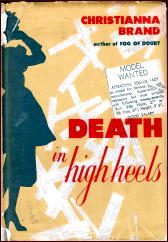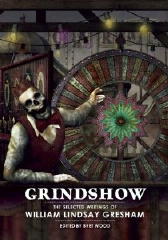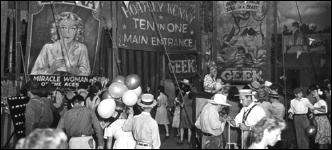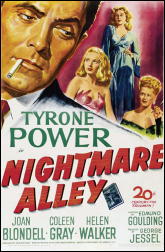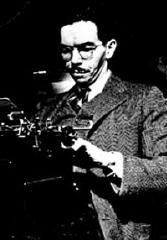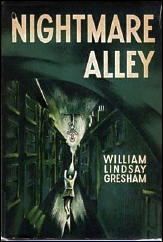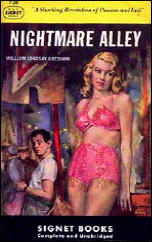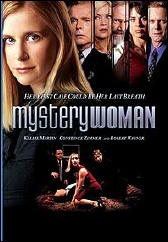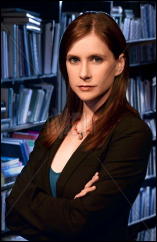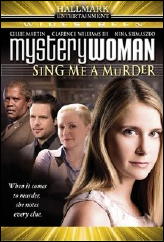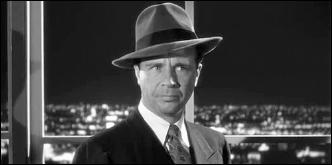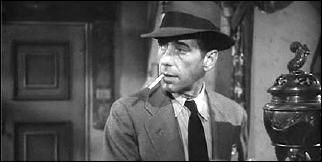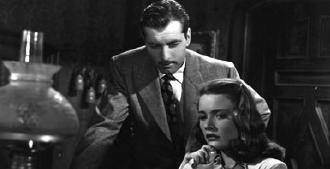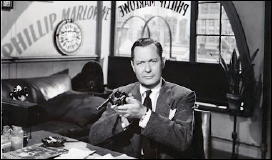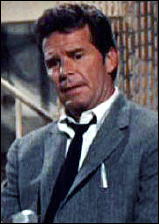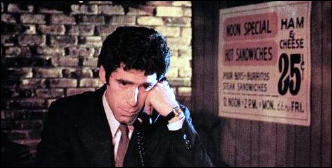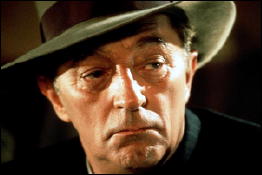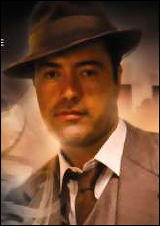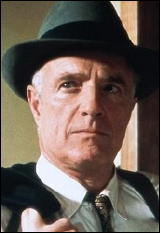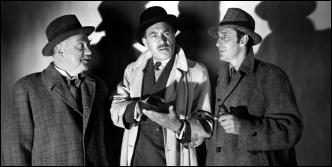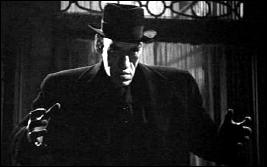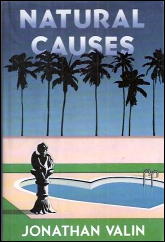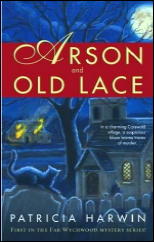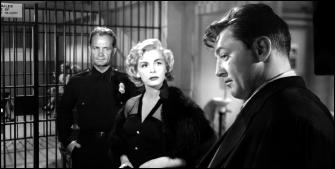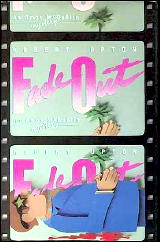Wed 23 Oct 2013
A TV Series Review by Michael Shonk: FALLEN ANGELS (1993, 1995).
Posted by Steve under Reviews , TV mysteries[16] Comments
FALLEN ANGELS. Showtime, 1993 & 1995. Showtime Presentation / Mirage Enterprises in association with Propaganda Films. Series created by William Horberg. Fallen Angels themes written by Elmer Bernstein and Peter Bernstein. Music by Peter Bernstein.
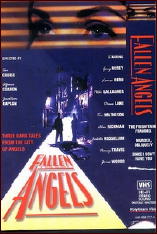
Season One: 1993 – 6 episodes. Executive Producer: Sydney Pollack. Produced by William Horberg, Lindsay Doran and Steve Golin. Season Two: 1995 – 9 episodes. Executive Producers: Sydney Pollack and Lindsay Doran. Supervising Producer: Steve Golin. Producers: Stuart Cornfeld and William Horberg.
Pure noir and television have never really found the perfect match, unlike the hardboiled detective and TV. Perhaps the closest TV series to achieve pure noir was Showtime’s Fallen Angels.
Set in the film noir world of Los Angeles, 1940s, the series production values and music were its best assets. The original music by Elmer Bernstein and his son Peter and performed by Teddy Edwards mixed well with the heavy use of music from the time period featuring such legendary performers as Billie Holiday and Charlie Parker.
The series opened with a mood setting prologue directed by Phil Joanou. Season One featured the sultry talents of Lynette Walden as the host “Fay Friendly.†After a year without any original episodes the series returned with “Fay Friendly†replaced by the voice-over narration of Miguel Ferrer. Both worked well.
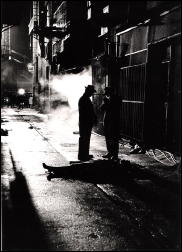
Fallen Angels most interesting choice was the decision to use source material from some of the best writers of noir and hardboiled fiction, writers such as David Goodis, Jim Thompson, Evan Hunter, Walter Mosley, James Ellroy and Mickey Spillane. Of course Hammett and Chandler were included.
I hope to someday see the episode “Flypaper†with Donald Westlake’s adaption of the Dashiell Hammett Continental Op story, even if the casting of Christopher Lloyd as the Continental Op was completely wrong (something common to every adaption of the Op).
Fallen Angels featured many talented directors including Steven Soderbergh, John Dahl, Jim McBride, Agnieszka Holland and Alfonso Cuaron (whose current film Gravity is the hit of this fall movie season). The series also let a few stars such as Tom Cruise, Kiefer Sutherland and Tom Hanks take a turn behind the camera.
The cast for the anthology series was a varied and talented group including Tom Hanks, Laura San Giacomo, Darren McGavin, Danny Glover, Nancy Travis, James Woods, Dana Delany, Gary Oldman, Marg Helgenberger, William Peterson and Gary Busey.
YouTube currently has some episodes available to view. Some are missing the prologue or have foreign language subtitles but all remain worth watching.
“Murder, Obliquely†(1993)
Cast: Laura Dern, Alan Rickman, and Diane Lane. Based on a short story by Cornell Woolrich. Teleplay by Amanda Silver. Director of Photography: Emmanuel Lubezki. Directed by Alfonso Cuaron. *** Laura Dern is Annie, a plain dull woman no man has ever dated twice. Then one night she falls for bad boy Dwight (Alan Rickman) who is having problems with the cheating love of his life, Bernette (Diane Lane).
This episode fails in many ways, first with the casting of the beautiful and talented Laura Dern as Annie. Yes, make-up and hair helped plain her down, but nothing could hide that she possesses a body no heterosexual male would reject. Dern and the rest of the talented cast were wasted on the under developed characters of the flawed script.
Writer Amanda Silver was loyal to the short story’s words but not the subtext. Time limits forced Silver to condense the short story too much, removing the wit and depth of the characters for the sake of highlighting the predictable action.
For example, Woolrich had taken the cliché bad girl and gave her an insecure side that made Bernette more sympathetic to the reader and made Dwight more unlikeable. The script missed those moments, disabling the talented Diane Lane’s performance, and making Dwight more a victim than a villain.
The story was about a lonely spinster in waiting and her falling for the “final†love of her life. The TV version ends differently from the short story with the TV version more open ended. This sacrificed Woolrich’s ending that made the reader ache from the sad loneliness of Annie’s future, making me wonder if anyone with the TV show understood Woolrich’s point.
Director Alfonso Cuaron heavy use of close ups, the most emotional of all camera angles, gave the story an emotional kick it needed and his use of the master shot added to the noir mood.
Other episodes on YouTube are much the same, good but lacking in depth.
“Professional Man†(1995)
Cast: Brendan Fraser, Bruce Ramsay and Peter Coyote. Based on a short story by David Goodis. Teleplay by Howard A. Rodman. Director of Photography: Robert Stevens. Directed by Stephen Soderbergh. *** Elevator boy finds himself in a deadly love triangle at his other job.
“The Quiet Room†(1993)
Cast: Joe Mantegna, Bonnie Bedelia and Peter Gallagher. Based on a short story by Jonathan Craig. Teleplay by Howard A. Rodman. Director of Photography: Emmanuel Lubezki. Directed by Steven Soderbergh. *** Two crooked cops/lovers shakedown of prostitutes and their Johns goes tragically wrong.
Anthologies are expensive to produce with all the sets, settings, and cast changing with every episode, high costs most likely played a role in the series end. But pure noir demands the stand-alone story. It tells a personal journey of a doomed person’s fall from respectability, something impossible for a character to do on a weekly basis.
Pure noir is not dependent on mystery unless it is the mystery of what can move us to willingly destroy ourselves. Noir is the meanness of such human emotions as love, anger and greed. To enjoy noir one must understand the characters. Not only understand why they make the choices they make but how they ended up facing those choices. Short stories such as Woolrich’s “Murder, Obliquely†did this, but the series adaptations failed to bring that vital element to the small screen.
Reducing complex character driven stories of noir to thirty-minutes was the fatal flaw of Fallen Angels. Any character driven television drama needs at least sixty-minutes, preferably even longer to properly tell the story and portray the subtext of words not spoken.
There was a book released, Six Noir Tales Told for Television (Grove Press 1993) featuring Fallen Angels first season scripts and the original short stories. While currently there is no DVD or official streaming/downloading available of the series there were two pre-recorded videotapes released with each featuring three episodes.
